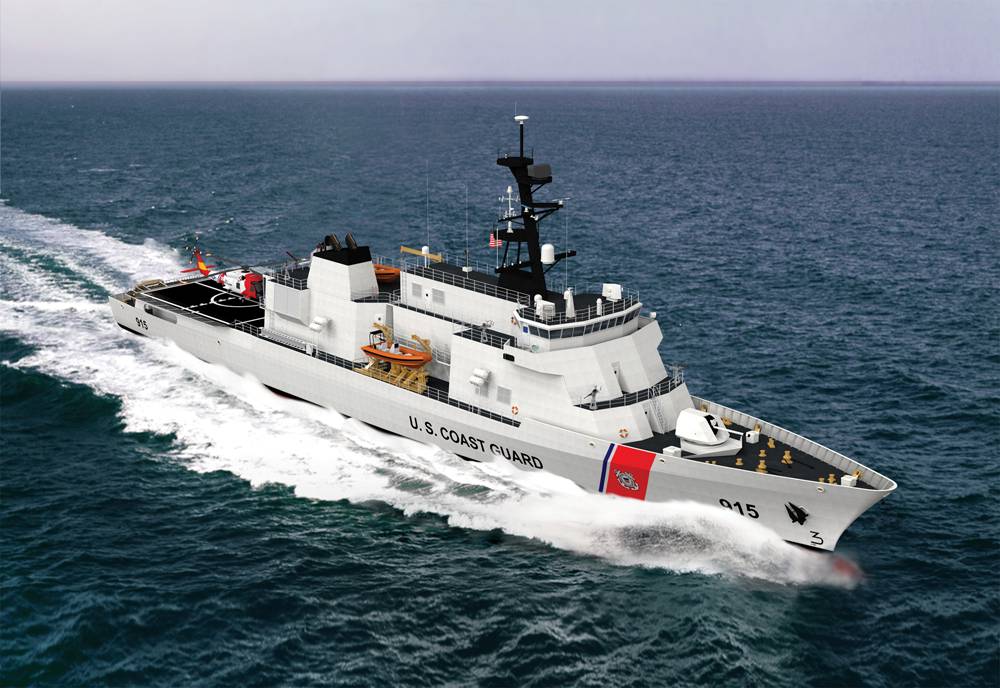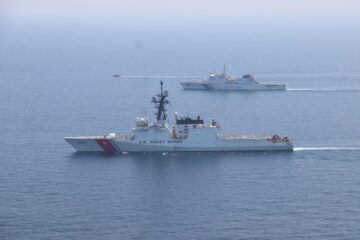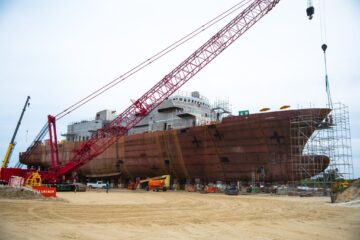The Offshore Patrol Cutters (OPC) will form the backbone of the U.S. Coast Guard’s (USCG) medium-endurance Cutter fleet that the 270-foot Famous-class and the 210-foot Reliance-class (WMEC) have served dutifully for about 25 to 50 years. Named the Heritage-class, the OPCs (USCG designation WMSM) are 4,320 long tons, 360 feet long with a beam of 54 feet, and have a speed of 22.5 knots (Legacy WMECs sail at 19.5 for the Famous-class and 18 knots for the Reliance-class, respectively).

OPCs are powered by Fairbanks Morse marine diesel engines that provide a range of 10,200 nautical miles (11,737 miles or 18,888 kilometers) at 14 knots and have a sustained speed of 17 knots. OPCs are armed with a Mark 110 57mm Bofors rapid-fire gun and a Mark 38 MOD 3 25mm autocannon with 7.62mm chaingun over the helicopter hangar (not including remote and crew-served .50 caliber M2HB heavy machine gun mounts). Endurance at sea is rated at 60 days and OPCs will be manned by up to 126 crewmembers.
“The Offshore Patrol Cutter] provides the midrange capability in the Coast Guard’s layered defense concept, filling the role between the NSC [National Security Cutter] and FRC [Fast Response Cutter] and replacing the service’s two classes of aging medium endurance cutters [WMECs]. The OPC will feature increased range and endurance, more powerful weapons, a larger flight deck, and improved C4ISR equipment, and will accommodate aircraft and boat operations in higher sea states.“
— U.S. Coast Guard website on the Offshore Patrol Cutter
Naval News asked the U.S. Coast Guard eight questions regarding the Offshore Patrol Cutters. Brian Olexy, Communications Manager with the U.S. Coast Guard Acquisition Directorate, replied.
Naval News: What is the current construction and funding status of the Offshore Patrol Cutters?
Brian Olexy: The Coast Guard has received funding for the production of the first three OPCs and long lead-time materials for the fourth cutter. Production of the first three OPCs is currently underway: The first OPC is approximately 59% complete; The second OPC is approximately 37% complete, and the third is approximately 5% complete. Steel-cutting to support OPC three[’s] production began September 27, 2021.

Naval News: How will the OPCs be deployed and where to: drug wars, illegal fishing, ship inspections, coastal security, Arctic deployments, etc.? Will the OPCs free up and make the National Security Cutters (NSC) deploy further overseas?
Brian Olexy: The OPC will directly support the Coast Guard Western Hemisphere Strategy as well as nine of the 11 Coast Guard statutory missions including fisheries, alien migrant interdiction operations, and defense operations. They will also be able to serve as mobile command and control platforms for surge operations, such as hurricane response, mass migration incidents, and other events. The OPCs will also support Arctic objectives by effectively regulating and protecting emerging commerce and offshore energy exploration activities in Alaska on a seasonal basis. The planned 25 OPCs will serve as the backbone of the Coast Guard’s major cutter fleet, contributing over 70% of the total offshore fleet presence when completed. Its range and endurance profiles are specifically tailored to complement the higher-endurance of the National Security Cutter and the nearer-shore capabilities of the Fast Response Cutter.
Naval News: What makes the new OPCs more specialized and capable than the WMECs of the Famous and Reliance-class and how does the USCG envision the Heritage-class helping the USCG in ways that the current WMECs cannot?
Brian Olexy: The operational readiness of the 40-year-old medium endurance cutter fleet has declined and become increasingly resource-intensive to maintain and support. While efforts like the In-service Vessel Sustainment (ISVS) program have improved WMEC readiness, the modern maritime security environment has evolved since these assets first entered service. In many cases, the new challenges presented by this modern environment are not fully answerable with these legacy designs, and the OPC was developed with the needs of the modern maritime security environment in mind.

Naval News: How does the USCG intend to act upon the facts that the new OPCs have extra speed, dimensions, and longer range compared to the existing WMECs; what would the USCG be most overjoyed with the new OPC design?
Brian Olexy: The OPC’s design and performance requirements are specifically tailored to meet the challenges of the modern maritime security environment. The OPC’s range and endurance will enable persistent operational presence in the offshore environment and make it an effective instrument for Coast Guard offshore operations, a capability that is critical to national security. Additionally, its design incorporates state-of-the-market technology and systems, which increases supportability and reduces the risk of lost operational time due to unplanned maintenance or repair. The OPC design also introduces a few unique clean power and energy efficiency initiatives such as a bulbous bow, auxiliary propulsion motor for station keeping, and an integrated propeller-rudder system for optimized hydrodynamic efficiency.
Naval News: What will become of the decommissioned WMECs once the new OPCs enter service?
Brian Olexy: Medium-endurance cutter decommissioning is synchronized with OPC commissionings to ensure continuous operations. The Coast Guard will follow a prescribed federal government process for disposal of excess defense articles that may include sales or transfers to allied foreign governments, non-profits, or other governmental entities.
Naval News: Will the OPCs have dedicated aviation assets such as HITRON helicopters or UASs on them for mission deployments compared to the NSCs?
Brian Olexy: The OPC is designed to embark aviation crews and is capable of hangaring an MH-60 or MH-65. This cutter also has space and weight reserved for UAS operations.
Naval News: Will the Mark 38 MOD2 be changed out now that the US Navy is planning for Mark 38 MOD4s with 30mm?
Brian Olexy: The OPC program includes each cutter receiving one MK 38 MOD 3 with 7.62 mm co-axial gun. There is no plan at this time to change to a MK 38 MOD 4.
Naval News: When will the first few OPCs enter active service due to construction delays from Hurricane Michael in 2018 and COVID-19? Has this delay affected costs or upgraded some systems with newer technologies due to the delay?
Brian Olexy: The Coast Guard anticipates delivery of the first OPC in the third quarter of the fiscal year 2023. The OPC program schedule requires completion of the initial operational test and evaluation (IOT&E) of the lead OPC by the end of the first quarter of the fiscal year 2025. The Navy-Type Navy-Owed equipment being provided has matured and the most operationally relevant equipment will be installed to mitigate obsolescence.






